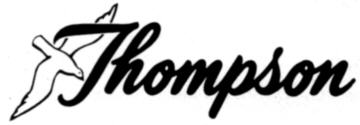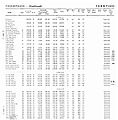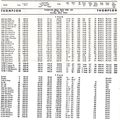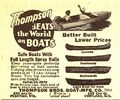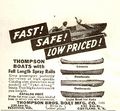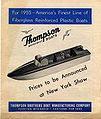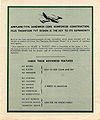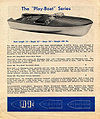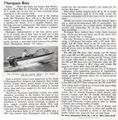Difference between revisions of "Thompson Bros"
(created link to T&T Boats) |
(added 1957 article) |
||
| (16 intermediate revisions by the same user not shown) | |||
| Line 12: | Line 12: | ||
<br><br> | <br><br> | ||
| − | When the recreational boom of the fifties hit, Thompson took full advantage of the demand for outdoor recreational products. They had two factories turning out wooden boats and canoes. [[Cruisers Inc.|Cruisers, Inc.]] of Oconto, Wisconsin began operations in 1953 as a second-generation venture. They also made wooden boats, concentrating upon clinker or lapstrake hulls. Thompson Skis, Inc. of Crivitz, Wisconsin, another family enterprise was making wooden water skis, aquaplanes, and disks. | + | When the recreational boom of the fifties hit, Thompson took full advantage of the demand for outdoor recreational products. They had two factories turning out wooden boats and canoes. [[Cruisers Inc.|Cruisers, Inc.]] of Oconto, Wisconsin began operations in 1953 as a second-generation venture. They also made wooden boats, concentrating upon clinker or lapstrake hulls. [[Thompson Skis|Thompson Skis, Inc.]] of Crivitz, Wisconsin, another family enterprise was making wooden water skis, aquaplanes, and disks. |
<br><br> | <br><br> | ||
| Line 30: | Line 30: | ||
<br><br> | <br><br> | ||
| − | Another unique example of attempts to grab a share of the non-wood boat markets took place in early 1959 with the formation of Thompson Royal-Craft, Inc. at Cortland, New York. It was established by second generation Thompson boat builders Glenn Thompson and his cousins Ted Jr. and Bob Thompson. They used U.S. Rubber’s “Royalite,” a one piece molded hull. They made several runabout models plus a dingy, sailboat, and canoe. All but the canoe were soon dropped from the line. | + | Another unique example of attempts to grab a share of the non-wood boat markets took place in early 1959 with the formation of Thompson Royal-Craft, Inc. at Cortland, New York. It was established by second generation Thompson boat builders Glenn Thompson and his cousins Ted Jr. and Bob Thompson. They used [[US Rubber|U.S. Rubber’s]] “Royalite,” a one piece molded hull. They made several runabout models plus a dingy, sailboat, and canoe. All but the canoe were soon dropped from the line. |
<br><br> | <br><br> | ||
| Line 57: | Line 57: | ||
<br><br> | <br><br> | ||
| − | In 1971-72 they built a new factory at Peshtigo especially suited for construction of fiberglass boats. The product line was expanded through the acquisition of Tom Sawyer Boats and Sidewinder Boats in 1974. Production of both lines was moved to Peshtigo. In late 1977 Thompson acquired the assets of [[Winner|Winner Boat Company]] as well. Winner’s product line was moved from Dickson, Tennessee to Peshtigo. | + | In 1971-72 they built a new factory at Peshtigo especially suited for construction of fiberglass boats. The product line was expanded through the acquisition of [[Tom Sawyer|Tom Sawyer Boats]] and [[Sidewinder|Sidewinder Boats]] in 1974. Production of both lines was moved to Peshtigo. In late 1977 Thompson acquired the assets of [[Winner|Winner Boat Company]] as well. Winner’s product line was moved from Dickson, Tennessee to Peshtigo. |
<br><br> | <br><br> | ||
| Line 63: | Line 63: | ||
<br><br> | <br><br> | ||
| − | Padek made arrangements for their largest model, the 28-foot Flagship Yacht to be made for them by IMP Boats of Iola, Kansas sometime in the late 1970s. | + | Padek made arrangements for their largest model, the 28-foot Flagship Yacht to be made for them by [[IMP|IMP Boats]] of Iola, Kansas sometime in the late 1970s. |
<br><br> | <br><br> | ||
| Line 81: | Line 81: | ||
<br><br> | <br><br> | ||
| − | Trouble struck in 1997 when Thompson, once again, closed down. By 1998 they were back in business and making boats in limited production. They even brought back the old 1950s-1960s company logo, to distance themselves from the tumultuous mid 1990s. Two years later Yar-Craft of Menominee, Michigan was using the St. Charles facility to mold their models. There were rumors that Yar-Craft was in negotiations to purchase the assets of Thompson with the idea of keeping the Thompson “Fisherman” lines and abandoning the remainder of the models. The alleged deal never materialized and by late 2001 Thompson was closed down. The phone lines were disconnected and the facility was locked up. | + | Trouble struck in 1997 when Thompson, once again, closed down. By 1998 they were back in business and making boats in limited production. They even brought back the old 1950s-1960s company logo, to distance themselves from the tumultuous mid 1990s. Two years later [[Yar-Craft]] of Menominee, Michigan was using the St. Charles facility to mold their models. There were rumors that Yar-Craft was in negotiations to purchase the assets of Thompson with the idea of keeping the Thompson “Fisherman” lines and abandoning the remainder of the models. The alleged deal never materialized and by late 2001 Thompson was closed down. The phone lines were disconnected and the facility was locked up. |
<br><br> | <br><br> | ||
| Line 99: | Line 99: | ||
'''Model Info:''' | '''Model Info:''' | ||
<gallery> | <gallery> | ||
| − | File:Thompsonbrosbb001.jpg|1955 Thompson Bros outboard models | + | File:Thompsonbrosbb001.jpg|1955 Thompson Bros outboard boat models |
| − | File:Thompsonbrosbb002.jpg|1955 to 1957 Thompson Bros outboard models | + | File:Thompsonbrosbb002.jpg|1955 to 1957 Thompson Bros outboard boat models |
| − | File:Thompsonbrosbb003.jpg|1958 to 1959 Thompson Bros outboard models | + | File:Thompsonbrosbb003.jpg|1958 to 1959 Thompson Bros outboard boat models |
| − | File:Thompsonbrosbb004.jpg|1960 to 1962 Thompson Bros outboard models | + | File:Thompsonbrosbb004.jpg|1960 to 1962 Thompson Bros outboard boat models |
| + | File:Thompsonbb007.jpg|1962 Thompson inboard boat models | ||
| + | File:Thompsonbrosbb005.jpg|1965 to 1966 Thompson Bros outboard boat models | ||
| + | File:Thompsonbrosbb006.jpg|1967 to 1971 Thompson Bros outboard boat models | ||
</gallery> | </gallery> | ||
| Line 115: | Line 118: | ||
<gallery> | <gallery> | ||
File:Thompsona48001.jpg|1948 Thompson ad | File:Thompsona48001.jpg|1948 Thompson ad | ||
| + | </gallery> | ||
| + | |||
| + | |||
| + | '''1951 Info:''' | ||
| + | <gallery> | ||
| + | File:Thompsonbrosa51001.jpg|1951 Thompson Ad | ||
</gallery> | </gallery> | ||
| Line 125: | Line 134: | ||
File:Thompsonb55004.jpg | 1955 Brochure p4 | File:Thompsonb55004.jpg | 1955 Brochure p4 | ||
File:Thompsonb55005.jpg | 1955 Thompson ad card | File:Thompsonb55005.jpg | 1955 Thompson ad card | ||
| + | </gallery> | ||
| + | |||
| + | |||
| + | '''1957 Info:''' | ||
| + | <gallery> | ||
| + | File:Thompsona57001.jpg|1957 Thompson Bros Boats Ad | ||
| + | File:Thompsona57002.jpg|1957 Thompson Bros Boats Article | ||
| + | </gallery> | ||
| + | |||
| + | |||
| + | '''1958 Info:''' | ||
| + | <gallery> | ||
| + | File:Thompsonbrosa58001.jpg|1958 Thompson Ad | ||
| + | File:Thompsonbrosa58002.jpg|1958 Thompson Selling Ad | ||
| + | File:Thompsona58002.jpg|1958 Thompson Ad | ||
| + | File:Thompsonbrosa58003.jpg|1958 Thompson Bros New Models Article | ||
| + | File:Thompsonbrosa58004.jpg|1958 Thompson Bros New Models Article | ||
| + | </gallery> | ||
| + | |||
| + | |||
| + | '''1959 Info:''' | ||
| + | <gallery> | ||
| + | File:Thompsona59002.jpg|1959 Thompson "Skipper the Best!" Ad | ||
| + | File:Thompsona59001.jpg|1959 Thompson Lapstrake Boats Article | ||
| + | </gallery> | ||
| + | |||
| + | |||
| + | '''1960 Info:''' | ||
| + | <gallery> | ||
| + | File:Thompsonbrosa6001.jpg|1960 Thompson Ad | ||
| + | </gallery> | ||
| + | |||
| + | |||
| + | '''1961 Info:''' | ||
| + | <gallery> | ||
| + | File:Thompsonbrosa61001.jpg|1961 Thompson Bros Canoe Ad Flyer | ||
| + | File:Thompsonbrosletter61001.jpg|Thompson Bros Dealer Letter | ||
| + | File:Thompsonbrosletter61002.jpg|Thompson Bros Dealer Application | ||
| + | File:Thompsonbrosa61002.jpg |1961 Thompson Ad | ||
</gallery> | </gallery> | ||
| Line 131: | Line 179: | ||
<gallery> | <gallery> | ||
File:Thompsona63002.JPG | 1963 Ad | File:Thompsona63002.JPG | 1963 Ad | ||
| + | </gallery> | ||
| + | |||
| + | |||
| + | '''1964 Info:''' | ||
| + | <gallery> | ||
| + | File:Thompsonb64001.jpg|1964 Thompson Bros flyer, p1 | ||
| + | File:Thompsonb64002.jpg|1964 Thompson Bros flyer, p2 | ||
| + | File:Thompsonb64003.jpg|1964 Thompson Bros flyer, p3 | ||
| + | File:Thompsonb64004.jpg|1964 Thompson Bros flyer, p4 | ||
| + | File:Thompsonb64005.jpg|1964 Thompson Bros flyer, p5 | ||
</gallery> | </gallery> | ||
| Line 245: | Line 303: | ||
| − | [http://fiberglassics.com/ | + | '''1997 Information''' |
| + | <gallery> | ||
| + | File:Thompsonb97001.jpg|1997 Thompson Brochure, p1 | ||
| + | File:Thompsonb97002.jpg|1997 Thompson Brochure, p2 | ||
| + | File:Thompsonb97003.jpg|1997 Thompson Brochure, p3 | ||
| + | File:Thompsonb97004.jpg|1997 Thompson Brochure, p4 | ||
| + | File:Thompsonb97005.jpg|1997 Thompson Brochure, p5 | ||
| + | File:Thompsonb97006.jpg|1997 Thompson Brochure, p6 | ||
| + | File:Thompsonb97007.jpg|1997 Thompson Brochure, p7 | ||
| + | File:Thompsonb97008.jpg|1997 Thompson Brochure, p8 | ||
| + | File:Thompsonb97009.jpg|1997 Thompson Brochure, p9 | ||
| + | File:Thompsonb97010.jpg|1997 Thompson Brochure, p10 | ||
| + | File:Thompsonb97011.jpg|1997 Thompson Brochure, p11 | ||
| + | File:Thompsonb97012.jpg|1997 Thompson Brochure, p12 | ||
| + | File:Thompsonb97013.jpg|1997 Thompson Brochure, p13 | ||
| + | File:Thompsonb97014.jpg|1997 Thompson Brochure, p14 | ||
| + | File:Thompsonb97015.jpg|1997 Thompson Brochure, p15 | ||
| + | File:Thompsonb97016.jpg|1997 Thompson Brochure, p16 | ||
| + | File:Thompsonb97017.jpg|1997 Thompson Brochure, p17 | ||
| + | File:Thompsonb97018.jpg|1997 Thompson Brochure, p18 | ||
| + | File:Thompsonb97019.jpg|1997 Thompson Brochure, p19 | ||
| + | File:Thompsonb97020.jpg|1997 Thompson Brochure, p20 | ||
| + | File:Thompsonb97021.jpg|1997 Thompson Brochure, p21 | ||
| + | File:Thompsonb97022.jpg|1997 Thompson Brochure, p22 | ||
| + | File:Thompsonb97023.jpg|1997 Thompson Brochure, p23 | ||
| + | File:Thompsonb97024.jpg|1997 Thompson Brochure, p24 | ||
| + | </gallery> | ||
| + | |||
| + | |||
| + | [http://www.fiberglassics.com/index.php?searchword=Thompson&ordering=newest&searchphrase=all&Itemid=88&option=com_search Thompson Boats in Use] | ||
Latest revision as of 18:52, 10 May 2021
Thompson’s Fiberglass Boats
by Andreas Jordahl Rhude
05 January 2000
Revised 26 September 2002
Fiberglass began to overtake the wooden boat markets in the late 1950s and into the 1960s. Many of the established wooden boat manufacturers resisted the change to glass, having a mindset that a high quality wooden boat could out perform, out sell, and outlast any fiberglass vessel. The Thompsons of Thompson Brothers Boat Manufacturing Company of Peshtigo, Wisconsin and Cruisers, Inc. of Oconto, Wisconsin were amongst this group.
Thompson began its operations in 1904 when brothers Peter and Christ Thompson built an anti-leak wooden canoe using the family barn as a workshop. By 1912 they were joined by their four brothers: Edward, Adolph “Tom”, Richard, and Ted. Their sister Hanna became the office manager. Another sister, Nina, also worked for the company as did her husband, Secor Peterson. The business of Thompson Boats increased and their line of models were ever evolving.
When the recreational boom of the fifties hit, Thompson took full advantage of the demand for outdoor recreational products. They had two factories turning out wooden boats and canoes. Cruisers, Inc. of Oconto, Wisconsin began operations in 1953 as a second-generation venture. They also made wooden boats, concentrating upon clinker or lapstrake hulls. Thompson Skis, Inc. of Crivitz, Wisconsin, another family enterprise was making wooden water skis, aquaplanes, and disks.
During this same period, fiberglass boats began to be marketed by many companies. Thompson always experimented with various designs and products. Their 1955 line of boats included two all-fiberglass hulls with four unique offerings. According to an announcement in the Peshtigo Times in January, the glass hulls would be made for and sold under the Thompson name by an Ashtabula, Ohio builder (Peshtigo Times, 13 January 1955).
The 1955 Thompson catalog pictured the four glass boats. Model 1000, the “Starfire,” was a fourteen-foot outboard runabout made by Pla-Tank, Inc. of Springfield, Massachusetts. The “Play-Boat” series included three models, all with mahogany wooden decks. The use of wood above the hull kept the warmth and beautiful feel of their traditional line.
Classic boat expert Lee Wangstad suspects that Thompson probably made a production agreement with Molded Fiber Glass Company (MFG), which was based at Ashtabula. Somewhere along the line, however, something went awry. A full-page advertisement was taken out by Thompson Brothers in the trade paper The Boating Industry on 15 October 1955. It stated that contrary to previous announcements, Thompson would not have molded fiberglass clinker boats in their 1955 or 1956 lines. One explanation for Thompson abandoning fiberglass may be due to the fire that destroyed the vast majority of their Peshtigo factory in March 1955. They may have decided to focus their energies on rebuilding the facility and letting new ideas pass by for the time being.
Beginning in 1955 Thompson also offered to cover the outer hull of their cedar strip boats with fiberglass coating.
Since they never again mentioned any all fiberglass models in their literature, the efforts by Thompson were half-hearted during the fifties. It was not until their wood boat markets came to a near standstill a decade later that they cautiously entered the fiberglass field.
Another unique example of attempts to grab a share of the non-wood boat markets took place in early 1959 with the formation of Thompson Royal-Craft, Inc. at Cortland, New York. It was established by second generation Thompson boat builders Glenn Thompson and his cousins Ted Jr. and Bob Thompson. They used U.S. Rubber’s “Royalite,” a one piece molded hull. They made several runabout models plus a dingy, sailboat, and canoe. All but the canoe were soon dropped from the line.
In late 1964 Thompson consummated an agreement with Crownline Boats of Cairo, Illinois. Crownline made hulls for Thompson; the 14-foot G1400 and 15-foot G1500 models. Thompson was making the full V Super Deluxe 17-footer at Peshtigo. When Crownline went bankrupt in early 1965, Pete Thompson drove to Cairo and picked up the Thompson molds and brought them to Peshtigo.
They were smooth hulled boats, not the traditional lapstrake design adopted by late 1965 for the Thompson fiberglass line. Hulls were white with the exception of the G1500 Deluxe and G1550 Super Deluxe that had turquoise coloured hull and deck.
A Thompson ad in the February 1965 issue of Motor Boating magazine stated that they made fiberglass boats in 14, 15, 16, 17, and 20-foot lengths in addition to their traditional wooden boats. “Fiberglass Boats Made in Peshtigo” was a headline of the Peshtigo Times on 22 December 1965, announcing the formation of Thompson Fiberglass Boat Company. Pete Thompson, Ray’s son, was president. The new enterprise was a separate company from Thompson Brothers Boat but it was located within the same production facilities. The seventeen and a half-foot glass boat, model GV-180, was an outboard open model with lapstrake hull. The hull was white with the option of blue or olive green top strake, trim and upholstery.
“Is 62 years too old for new ideas?” This is what Thompson asked in a February 1966 ad in Motor Boating magazine. The ad went on to purport that they were indeed innovative, building the new full – V wood lapstrakes, all fiberglass sport boats, and the “Royalex” canoe, dingy, and eleven-foot fishing boat.
The 1966 Thompson catalog included three fiberglass models in 18, 16 and 15-foot lengths.
Was Thompson a little too late? Probably, because by the summer of 1966 the company was on the verge of bankruptcy and employment in the factory was down to a mere handful of men. On 11 August 1966 Dietrich and Gambrill, Inc. headed by Saul Padek, a Milwaukee area businessman, bought the ailing Thompson Brothers Boat for less than $4,000.00. It ended over sixty years of Thompson family ownership of the company. Padek declared bankruptcy one month later. Arrangements for paying creditors in full were formulated. Monthly payments commenced soon afterward and the final payout was on 15 March 1970.
Padek began the process to bring the company back to life and his chief means to do so, was to introduce more fiberglass models and slowly wean the wooden boats out of the product lines. The last wooden Thompson rolled out of the doors of the Peshtigo boat shop by 1970. By the end of 1967 the company had increased production by 300% and employment went up five fold (Peshtigo Times, 06 December 1967).
Thompson Boats had 110 full time employees by 1968, up from about twenty part timers in 1966. The company had weathered the storm. A Thompson Mallard GV-209 boat was air freighted to the Paris Boat Show in early 1969. Thompson also entered into a licensing agreement with A.B.R. ECOFIBER of Antwerp, Belgium wherein they would manufacture Thompson boats for sale throughout Europe (Peshtigo Times, 18 December 1968).
In 1971-72 they built a new factory at Peshtigo especially suited for construction of fiberglass boats. The product line was expanded through the acquisition of Tom Sawyer Boats and Sidewinder Boats in 1974. Production of both lines was moved to Peshtigo. In late 1977 Thompson acquired the assets of Winner Boat Company as well. Winner’s product line was moved from Dickson, Tennessee to Peshtigo.
The Winner acquisition proved to be a burden rather than an asset. Thompson was making 57 different models with this addition. The Winner models were difficult to make and Thompson lost money on each and every hull sold. When they bought Winner, Thompson was lead to believe Winner had 150 dealers that would come aboard. As it turned out, just a handful of Winner dealers remained loyal to the new set-up.
Padek made arrangements for their largest model, the 28-foot Flagship Yacht to be made for them by IMP Boats of Iola, Kansas sometime in the late 1970s.
Saul Padek sold Thompson in the spring of 1979. On March 10th, 1980 the company declared bankruptcy and was soon closed down. Dale and Dave Anderson bought Thompson at the bankruptcy court in the summer and everything was moved lock, stock and barrel to St. Charles, Michigan. New life was again breathed into Thompson Boat. One advantage of relocating was that policy and production changes could be implemented without the resistance that often arises in established enterprises. A few Thompson employees made the move to Michigan; otherwise they started with a clean slate.
Most boats made by Thompson were designed in house. Roger Devroy began working for the firm in 1969, ultimately becoming the principal designer of the boats. Having no formal training, he instinctively knew where to place interior components, engine, and how to shape the hull. Often times he would design a hull, make the mold, plug a hull from it and test the basic hull on the Saginaw River near St. Charles. If performance was not up to snuff, he would adjust the mold and start over. It was not until about 1990 that Thompson brought a trained designer on staff.
When Thompson relocated to St. Charles, they occupied the old Browning Aero-Craft boat works. The facility was old and not suited for production line manufacturing. But they had to make due with what was available. In addition, Browning left large amounts of toxic wastes in and near the plant. Thompson inherited these problems and was held responsible for their cleanup. They also suffered two fires in 1987. Thompson moved into a brand new 150,000 square foot facility in 1988. It was the most modern and well laid out operation in the boating industry after completion.
In 1987 and 1988 Thompson made 3,000 boats annually during peak years of boat sales. Sales dropped by a third the following year.
Rough seas again hit Thompson in 1993 when foreclosure proceedings against the firm began in mid May. According to published reports, Thompson owed around $8 million to Michigan National Bank of Flint. Thompson declared Chapter 11 bankruptcy on May 20th with a skeleton crew remaining on hand to ship completed boats to dealers. A buyer for the firm was its only hope. Ultimately new owners invigorated life into the company and the name was changed to Thompson Marine Products, Inc. sometime after 1994.
Trouble struck in 1997 when Thompson, once again, closed down. By 1998 they were back in business and making boats in limited production. They even brought back the old 1950s-1960s company logo, to distance themselves from the tumultuous mid 1990s. Two years later Yar-Craft of Menominee, Michigan was using the St. Charles facility to mold their models. There were rumors that Yar-Craft was in negotiations to purchase the assets of Thompson with the idea of keeping the Thompson “Fisherman” lines and abandoning the remainder of the models. The alleged deal never materialized and by late 2001 Thompson was closed down. The phone lines were disconnected and the facility was locked up.
The Yar-Craft association with Thompson in 2000-2001 is quite interesting. Yar-Craft was formed in 1969 by Jack Dallman at Menominee. He had been employed as vice – president and general manager of Thompson from 1967 to 1969 during the Saul Padek regime. Events nearly came full circle three decades later! How ironic would it have been for Yar-Craft, once a spin-off of Thompson, to become owner of Thompson?
Thompson could never be considered a pioneer of the fiberglass boat industry. Their entry into ‘glass boat production came more than a decade after the technology made inroads into the boating world. They did make a quality product and they used their long tradition of wooden boat building as a basis for successfully making the transition from one to another technology: wood to fiberglass.
For more Thompson history, see Rhude’s articles in Classic Boating magazine (Sept.-Oct. 1999), The BoatHouse magazine (April 1998), and The Brass Bell magazine (Summer 2000). The Thompson Dockside magazine and website also offers Thompson et.al. history (www.thompsondockside.com). <a href="www.thompsondockside.com" target="www.thompsondockside.com">www.thompsondockside.com</a>
Further information, including every known brochure of Thompson Boat at Peshtigo and Cortland, and Cruisers, Inc., T & T Boats, Inc., Thompson Royal-Craft, Thompson Skis, Inc. etc... is available for purchase on CD-ROM at www.wcha.org
Model Info:
1946 Info:
1948 Info:
1951 Info:
1955 Info:
1957 Info:
1958 Info:
1959 Info:
1960 Info:
1961 Info:
1963 Info:
1964 Info:
1968 Info:
1971 Info:
1972 Information
1973 Information
1974 Information
- Thompsonb74007.jpg
1974 Brochure, page 7 (Missing)
1979 Information
1980 Information
1997 Information
